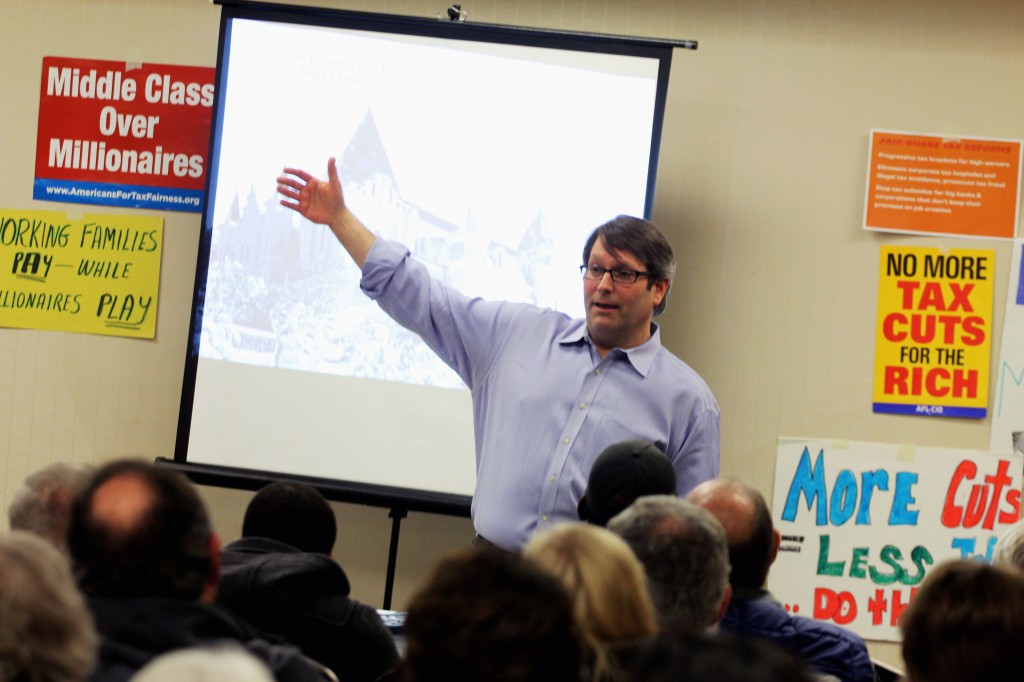
Gov. Andrew Cuomo’s 2014 proposed executive budget has angered some local activist groups, especially with its cuts that could neglect upstate New York.
The “Budget Teach-In,” held on Wednesday, was sponsored by groups including Citizen Action of New York, Alliance for Quality Education (AQE) and New Yorkers for Fiscal Fairness (NYFF). The event served to highlight different ways the proposed budget, and its subsequent cuts, could hurt the working class while benefiting the “1 percent.”
“This campaign is called NY Inequality,” said Ron Deutsch, the keynote speaker and a member of NYFF. “We are number one in income inequality. That is the gap between those who earn the most and those who earn the least, and NY has this dubious honor.”
The presentation, held at the DoubleTree Hotel on Water Street, featured both an analysis of the executive budget and a call to arms by a number of advocacy organizations.
“We wanted to show how the governor’s budget impacts all of New York,” said Lawrence Parham of Citizen Action NY, one of the event’s organizers. “One thing we wanted to highlight was how the budget gives additional funding to wealthy New Yorkers, and less to New Yorkers from low-income neighborhoods. There is an imbalance in that budget in how it affects upstate and downstate. There already is a gap, and the budget just highlights it even more.”
One of the main issues organizers had with the budget was changes in property taxes. The budget includes a “freeze” in which the taxes on property would not rise. This freeze would mean rebates on property value to encourage growth. Because property taxes tend to be higher in downstate areas like New York City and Westchester — and lower in upstate areas like the Southern Tier — organizers said these rebates would provide for less money going back to the community, like for public education, in lower-income neighborhoods with less property value.
“Wealthy school districts have incredibly high graduation rates. Poor school districts have incredibly low graduation rates. There’s a correlation here that people don’t want to acknowledge,” Deutsch said. “Kids living in lower poverty need a little more help to get there.”
Not everyone is on board with this argument. Gov. Cuomo has rebutted that New York spends the most in the nation per pupil in public schools, with $16,752 spent per pupil for the 2011 fiscal year, according to the latest available data. The new budget also touts funding for universal pre-K and the expansion of after-school programs.
However, Parham stressed it wasn’t the amount, but the allocation.
“The governor thinks because New York spends more on pupils than any other state justifies the fact that money is not the answer,” Parham said. “It’s not the amount of money, but how much is being allocated, and that the money goes to the students in need. Here it goes to wealthy schools. It’s a matter of distribution.”
Emily Karol from the AQE disagreed, arguing that funding was, in fact, insufficient.
“The governor’s budget this year is the fact that it will simply not provide schools with enough funding to prevent more cuts to the classroom and begin to improve the quality of education,” Karol said. “AQE believes that it will take $1.9 billion to accomplish this.”
Neon posters claiming “Kids Pay for Millionaire’s Play” and “Middle Class over Millionaires” decorated the room, as the topic of conversation digressed with comments from the audience, such as “So how does the budget affect fracking?” and “What about the closing of mental illness facilities?”
Regardless, organizers said they found the event a success.
“Citizen Action and its events fight for racial, economic, social justice,” Parham said. “This bill affects every issue in every domain under our mission. It’s our mission to fight for students, not teachers, not school districts, but students. The disparity in funding directly affects students, disproportionality students of colors and from low-income neighborhoods.”
Students, too, found the budget and underlying economic culture to be questioned.
“We live in a corporatocracy,” said John Jones, a second-year graduate student studying social work. “So every political initiative is geared toward corporations. This event offers info about how it affects the Broome County area. But we need more people. More types of people.”
The budget was proposed Jan. 21. It is currently under deliberation by the NYS Senate.


